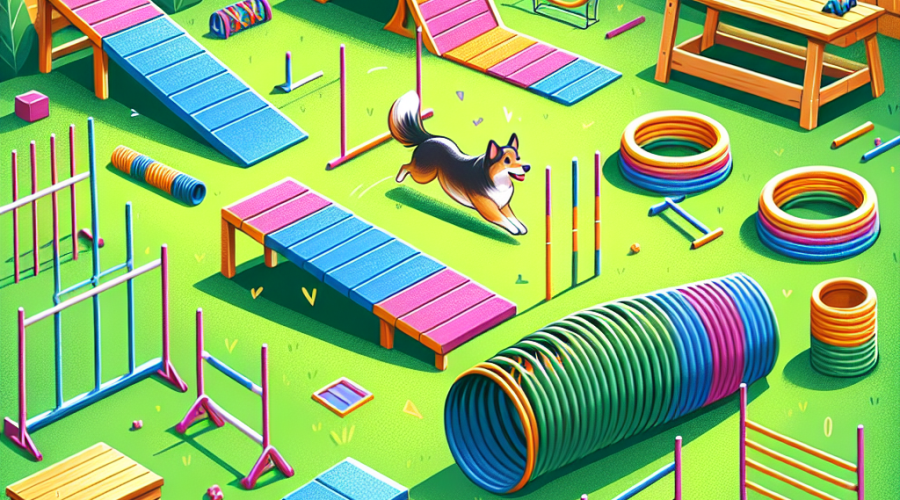Advancing Your Pet’s Agility: A Comprehensive Guide to Setting Up a DIY Pet Agility Course at Home
Ever wondered how to keep your four-legged friend both physically and mentally stimulated while at home? Or perhaps you’re seeking a fresh, fun activity that you and your pet can enjoy together? Well, you’re in luck! This comprehensive guide will show you how to set up a DIY pet agility course right in the comfort of your own home.
Why Pet Agility?
Before we delve into the nitty-gritty of setting up your course, let’s talk about why pet agility is such a fantastic activity. Agility training is more than just a form of exercise; it’s a holistic approach to pet care that promotes both physical health and mental stimulation.
It’s not just for dogs! Cats, rabbits, and even birds can benefit from agility training too. This activity challenges your pet’s mind, encourages problem-solving skills, and helps to build a stronger bond between you and your furry friend. It’s like a two-for-one deal, how can you resist?
Planning Your DIY Pet Agility Course
A well-thought-out plan is the first step in creating an effective pet agility course. You’ll need to consider the size and breed of your pet, their physical capabilities, and their level of training.
Keep in mind the space you have available. You don’t need a massive garden; a small backyard, or even an indoor space, can work just as well. Remember, this is meant to be a fun activity, so don’t stress if you don’t have a lot of room!
DIY Pet Agility Course Equipment
You’ll be surprised at how many agility course components you can create with household items. Let’s explore some of the basic equipment you’ll need:
1. Jumps: A broomstick placed between two chairs can create a simple jump.
2. Tunnels: Kids’ play tunnels work great here, or you can get creative with large cardboard boxes.
3. Weave Poles: These can be made easily using slalom ski poles, or even upright broom handles placed in the ground.
4. Pause Table: An old coffee table or a sturdy box can work.
5. See-Saw: This one might require a bit more DIY skills, but a long plank and a sturdy base can do the trick.
Remember, safety first! All DIY equipment should be sturdy and safe, with no sharp edges or loose parts that can harm your pet.
Training Your Pet On the Agility Course
Start by introducing your pet to each obstacle individually. Use treats or toys to lure them over jumps, through tunnels, and onto the pause table. Be patient, and remember to keep the training sessions short and fun.
Gradually, you can start linking the obstacles together. The ultimate goal is for your pet to be able to navigate the entire course with minimal direction from you. But remember, this is all about enjoyment, so don’t push too hard and always reward your pet for their efforts!
The Fun Factor
Have fun with it! The beauty of a DIY pet agility course is that it can be easily modified. Switch up the course layout, introduce new obstacles, or challenge your pet with speed trials. The possibilities are endless, and the enjoyment for both you and your pet is limitless.
The bottom line? A DIY pet agility course is a fantastic way to keep your pet active, entertained, and mentally stimulated. Plus, it’s a great bonding activity that’s fun for the whole family. So, what are you waiting for? Start planning your pet agility course today!
FAQs
Q: What is the importance of setting up a DIY pet agility course at home?
A: A pet agility course at home promotes physical activity, mental stimulation, and bonding between the pet and the owner. It also provides a convenient and cost-effective alternative to professional agility training.
Q: What type of equipment is necessary for a DIY pet agility course?
A: Essential equipment for a DIY pet agility course includes objects like cones, tunnels, and poles for weaving, which can be purchased or improvised using household items. Ensure that the equipment is safe and suitable for your pet’s size and abilities.
Q: Can all pets participate in agility training at home?
A: Yes, pets of all sizes can participate in agility training at home, however, it’s crucial to adjust the complexity and intensity of the course based on your pet’s size, age, breed and physical condition. Always consult your vet before introducing your pet to any new exercise regime.
Q: How can I motivate my pet to use the agility course?
A: You can motivate your pet to use the agility course through positive reinforcement such as treats, praise, or toys. It’s also important to introduce your pet to the course gradually, starting with simple obstacles before progressing to more complex ones.
Q: How often should my pet use the agility course?
A: The frequency of agility training depends on your pet’s health, fitness level, and attention span, but a good starting point is a few times a week. Always monitor your pet for fatigue and ensure they are enjoying the activity to avoid overexertion or stress.

